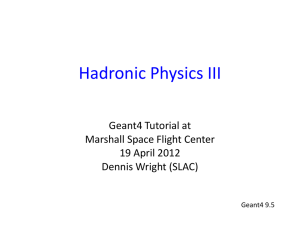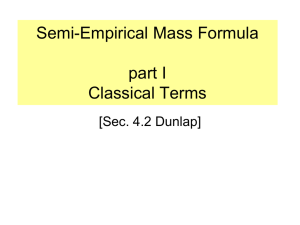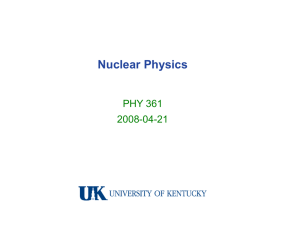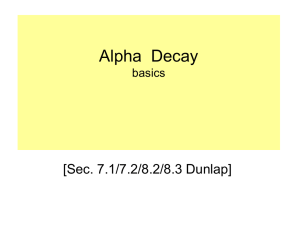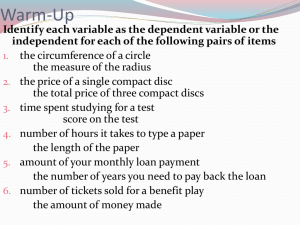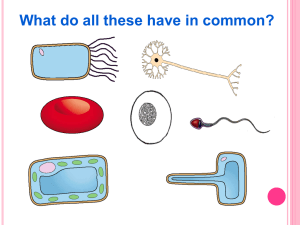PPT - Geant4
advertisement
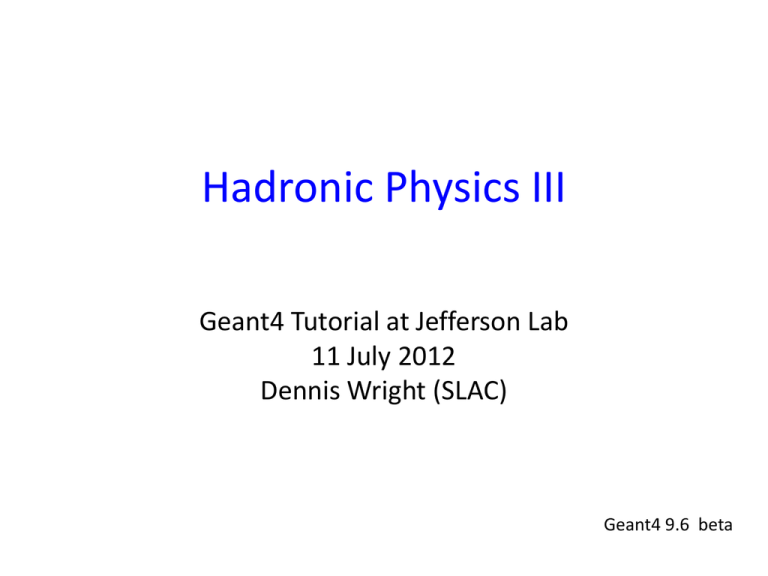
Hadronic Physics III Geant4 Tutorial at Jefferson Lab 11 July 2012 Dennis Wright (SLAC) Geant4 9.6 beta Outline • Gamma- and lepto-nuclear models • QCD string models • Quark-gluon string (QGS) model • Fritiof (FTF) model • Other models • CHIPS • capture • fission • Radioactive decay 2 Gamma- and Lepto-nuclear Processes • Geant4 models which are neither exclusively electromagnetic nor hadronic • gamma-nuclear • electro-nuclear • muon-nuclear • Geant4 processes available: • • • • G4PhotoNuclearProcess (implemented by two models) G4ElectronNuclearProcess (implemented by one model) G4PositronNuclearProcess (implemented by one model) G4MuonNuclearProcess (implemented by two models) 3 Gamma- and Lepto-nuclear Processes • Gammas interact directly with the nucleus • at low energies they are absorbed and excite the nucleus as a whole • at high energies they act like hadrons (pion, rho, etc.) and form resonances with protons and neutrons • Electrons and muons cannot interact hadronically, except through virtual photons • electron or muon passes by a nucleus and exchanges virtual photon • virtual photon then interacts directly with nucleus (or nucleons within nucleus) 4 Gamma- and Lepto-nuclear Models Gamma-nuclear Lepto-nuclear evirtual g g p s and nucleons ps and nucleons 5 Lepto-nuclear Models • G4MuonVDNuclearModel • Kokoulin model of EM cross section and virtual photon generation • Weizsacker-Williams conversion of virtual to real gamma • For Eg < 10 GeV, direct interaction with nucleus using Bertini cascade • For Eg > 10 GeV, conversion of g to p0, then interaction with nucleus using FTFP model • G4ElectroVDNuclearModel • Kossov model of EM cross section and virtual photon generation • all else identical to that in G4MuonVDNuclearModel • G4ElectroNuclearReaction • alternative to G4ElectroVDNuclerModel using CHIPS models 6 Gamma-nuclear Models • G4GammaNuclearReaction • • • • based on CHIPS (chiral invariant phase space) model interacts gamma directly with nucleus usually used up to 3.5 GeV to cover higher energies, needs to be coupled with QGSP model which can handle gammas above 3 GeV • As of Geant4 9.6 (beta) Bertini cascade can interact photons directly with the nucleus • an alternative to G4GammaNuclearReaction • can be used up to 10 GeV • needs to be paired with high energy gamma model (QGSP) 7 QCD String Models • Fritiof (FTF) valid for • p, n, p, K, L, S, W from 3 GeV to ~TeV • anti-proton, anti-neutron, anti-hyperons at all energies • anti-d, anti-t, anti-3He, anti-a with momenta between 150 MeV/nucleon and 2 GeV/nucleon • Quark-Gluon String (QGS) valid for • p, n, p, K from 15 GeV to ~TeV • Both models handle: • • • • building 3-D model of nucleus from individual nucleons splitting nucleons into quarks and di-quarks formation and excitation of QCD strings string fragmentation and hadronization 8 How the QCD String Model Works (FTF Case) • Lorentz contraction turns nucleus into pancake • All nucleons within 1 fm of path of incident hadron are possible targets • Excited nucleons along path collide with neighbors •n + n nD, NN, DD, D, •essentially a quark-level cascade in vicinity of path Reggeon cascade • All hadrons treated as QCD strings •projectile is quark-antiquark pair or quark-diquark pair •target nucleons are quark-diquark pairs 9 How the QCD String Model Works (FTF Case) • Hadron excitation is represented by stretched string • string is set of QCD color lines connecting the quarks • When string is stretched beyond a certain point it breaks • replaced by two shorter strings with newly created quarks, antiquarks on each side of the break • High energy strings then decay into hadrons according to fragmentation functions • fragmentation functions are theoretical distributions fitted to experiment • Resulting hadrons can then interact with nucleus in a traditional cascade 10 High Energy Nuclear Interaction nucleon projectile excited string 11 QGS Validation 12 FTF Validation 13 FTF Anti-deuteron Scattering 14 CHIPS (Chiral Invariant Phase Space) Model • Model originally used to de-excite nuclei after high energy interaction • has since been extended for use in stopping processes and gamma- and electro-nuclear models • experimental versions apply to high energy and ion-ion • Basic model principles: • u, d, s quarks all treated as massless (hence chiral invariant) • when two hadrons interact, a bag of partons is formed, all of which are distributed uniformly in phase space • this bag is called a “quasmon” and decays somewhat thermodynamically as partons fuse to form hadrons 15 p- Stopping in Nucleus (CHIPS) quasmon clusters of nucleons p- hadron escapes nucleus nuclear evaporation begins quasmon disappears 16 Capture Processes and Models • G4PionMinusAbsorptionAtRest • process with direct implementation (no model class) • G4PionMinusAbsorptionBertini ** • at rest process implemented with Bertini cascade model • G4KaonMinusAbsorption • at rest process with direct implementation • G4AntiProtonAnnihilationAtRest • process with direct implementation • G4FTFCaptureAtRest ** • process implemented for anti-protons by FTF model ** recommended 17 Capture Processes and Models • G4MuonMinusCaptureAtRest • process with direct implementation (no model class) • G4QCaptureAtRest • alternative to above, using CHIPS model • G4AntiNeutronAnnihilationAtRest • process with direct implementation • G4HadronCaptureProcess • in-flight capture for neutrons • model implementations: • G4LCapture : all incident energies • G4NeutronHPCapture (below 20 MeV) 18 Fission Processes and Models • G4HadronFissionProcess can use two models • G4LFission (mostly for neutrons) • G4NeutronHPFission (specifically for neutrons below 20 MeV) • A third model handles spontaneous fission as an inelastic process (rather than fission) • G4FissLib: Livermore Spontaneous Fission 19 Isotope Production • Special process originally designed to register recoil nuclei after any interaction • Now mostly outdated except if you use the LEP models • those models don’t produce recoil nuclei • Now implemented as a model running specifically with LEP code • To use: G4LENeutronInelastic* nmodel = new G4LENeutronInelastic; G4NeutronIsotopeProduction* prodModel = new G4NeutronIsotopeProduction; nmodel->RegisterIsotopeProductionModel(prodModel); 20 Radioactive Decay • Process to simulate radioactive decay of nuclei • in flight • at rest • a, b+, b– decay, electron capture (EC) implemented • Empirical and data-driven • data files taken from Evaluated Nuclear Structure Data Files (ENSDF) • half lives, nuclear level structure for parent and daughter nuclides, decay branching ratios, energy of decay process • If daughter of nuclear decay is an isomer, prompt deexcitation is done by using G4PhotonEvaporation 21 Radioactive Decay • Analog (non-biased) sampling is default • Biased sampling also implemented • enhance particular decays within a given time window • sample all decay modes with equal probability • split parent nuclide into a user-defined number of copies, letting each decay • enhance emission in a given direction 22 Forbidden b Decay Spectra • 23 Using Radioactive Decay • Can be accessed with messengers (biasing options, etc.) • To put in your physics list: G4RadioactiveDecay* theDecay = new G4RadioactiveDecay; G4ProcessManager* pmanager = G4ParticleTable::GetParticleTable()-> FindParticle(“GenericIon”)->GetProcessManager(); pmanager->AddProcess(theDecay); pmanager->SetProcessOrdering(theDecay, idxPostStep); pmanager->SetProcessOrdering(theDecay, idxAtRest); 24 Summary • Gamma-nuclear and lepto-nuclear processes are available for nuclear reactions initiated by non-hadrons • Two QCD string models are available for implementing high energy interactions • Fritiof (FTF) : the more versatile, covers many particle types, larger energy range • Quark-Gluon String (QGS) • Several stopping processes and models available • for m, p, K, anti-p, anti-n • Capture and fission (mostly for neutrons) • Radioactive decay is available to handle unstable nuclei 25
